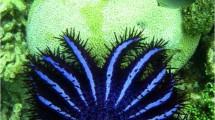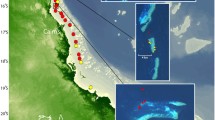Abstract
While tropical sea cucumbers are among the most conspicuous mobile invertebrates on coral reefs, information on their population biology and ecology is limited, particularly for dendrochirotids (suspension feeders). Here, we characterised a localised high-density population of the small and poorly described dendrochirotid, Colochirus quadrangularis, on a coral reef around Pom Pom Island, Malaysia. The high-density population was restricted to one site (Lobster Wall) on the south-eastern edge of Pom Pom Reef, with only 16 individuals found across all other sites. Average densities of this species were 669 ± 76 ind m−2 in the population epicentre, with a maximum of 1444 ind m−2, and mean body length across the population of 2.78 cm (SD ± 0.87). Colochirus quadrangularis showed preference for consolidated dead coral substrate while avoiding live corals. Asexual reproduction (transverse fission) was observed for the first time in this species along with cases of novel species interactions. There are no prior data for this species around Pom Pom Island, or elsewhere, to determine the drivers and impacts of this high-density Colochirus population, but these holothuroids may be an indication of the shifts in community states that can be expected for future coral reefs.




Similar content being viewed by others
References
Asha P, Johnson B, Ranjith L, Vivekanandan E, Subin C, Sheik Mohamed M (2015) Status of sea cucumber resources and impact of fishing ban on the livelihood of fishers in Gulf of Mannar and Palk Bay. Marine Fisheries Information Service; technical and extension series, pp 3–9
Bartoń K (2018) MuMIn: multi-model inference. R package version 1.42.1
Birkeland C (1989) The influence of echinoderms on coral reef communities. Echinoderm Studies 3:1–79
Bourjon P, Quod J-P (2019) Contribution to the knowledge of holothurian biodiversity at Reunion Island: two previously unrecorded dendrochirotid sea cucumbers species (Echinodermata: Holothuroidea). SPC Bêche-de-mer Inf Bull 27:27–30
Brooks ME, Kristensen K, van Benthem KJ, Magnusson A, Berg CW, Nielsen A, Skaug HJ, Mächler M, Bolker BM (2017) Modeling zero-inflated count data with glmmTMB. bioRxiv 1:132753
Chambers JM, Hastie T (1992) Statistical models in S. Wadsworth & Brooks/Cole Advanced Books & Software, Pacific Grove
Choo P (2008) Population status, fisheries and trade of sea cucumbers in Asia. In: Toral-Granda V, Lovatelli A, Vasconcellos M (eds) Sea cucumbers A global review of fisheries and trade FAO Fisheries and Aquaculture Technical Paper No 516. FAO, Rome, pp 81–118
Clements M, Wolfe K, Schwartz K, Byrne M (2019) Forever fissiparous: asexual propagation and stable demography in a tropical and geographically isolated asterinid sea star. Mar Biol 166:69
Conand C (1989) Les Holothuries Aspidochirotes du lagon de Nouvelle-Calédonie: biologie, écologie et exploitation. Ph.D. thesis, Université de Bretagne Occidentale, Brest, France
Conand C, Polidoro BA, Mercier A, Gamboa R, Hamel J-F, Purcell SW (2014) The IUCN Red List assessment of aspidochirotid sea cucumbers and its implications. SPC Bêche-de-mer Inf Bull 34:3–7
Dolmatov IY (2014a) Asexual reproduction in holothurians. Sci World J 2014:527234
Dolmatov IY (2014b) New data on asexual reproduction, autotomy, and regeneration in holothurians of the Order Dendrochirotida. Russ J Mar Biol 40:228–232
Eriksson H, Byrne M (2015) The sea cucumber fishery in Australia’s Great Barrier Reef Marine Park follows global patterns of serial exploitation. Fish Fish 16:329–341
Eriksson H, Fabricius-Dyg J, Lichtenberg M, Perez-Landa V, Byrne M (2010) Biology of a high-density population of Stichopus herrmanni at One Tree Reef, Great Barrier Reef, Australia. SPC Bêche-de-mer Inf Bull 30:41–45
Friedman K, Eriksson H, Tardy E, Pakoa K (2011) Management of sea cucumber stocks: patterns of vulnerability and recovery of sea cucumber stocks impacted by fishing. Fish Fish 12:75–93
Hamel J-F, Mercier A (1998) Diet and feeding behaviour of the sea cucumber Cucumaria frondosa in the St. Lawrence estuary, eastern Canada. Can J Zool 76:1194–1198
Hammond LS, Wilkinson CR (1985) Exploitation of sponge exudates by coral reef holothuroids. J Exp Mar Biol Ecol 94:1–9
Hasan MH (2005) Destruction of a Holothuria scabra population by overfishing at Abu Rharnada Island in the Red Sea. Mar Environ Res 60:489–511
Kumara P, Jayanatha J, Pushpakumara J, Bandara W, Dissanayake D (2013) Artificial breeding and larval rearing of three tropical sea cucumber species Holothuria scabra, Pseudocolochirus violaceus and Colochirus quadrangularis in Sri Lanka. SPC Bêche-de-mer Inf Bull 33:30–37
Lee J, Byrne M, Uthicke S (2008) The influence of population density on fission and growth of Holothuria atra in natural mesocosms. J Exp Mar Biol Ecol 365:126–135
Lenth R (2019) emmeans: estimated marginal means (least-squares means). R package version 1.3.3
Mladenov PV (1996) Environmental factors influencing asexual reproductive processes in echinoderms. Oceanol Acta 19:227–235
Norstrom AV, Nystrom M, Lokrantz J, Folke C (2009) Alternative states on coral reefs: beyond coral-macroalgal phase shifts. Mar Ecol Prog Ser 376:295–306
O’Loughlin PM, Harding C, Paulay G (2016) The sea cucumbers of Camden Sound in northwest Australia, including four new species (Echinodermata: Holothuroidea). Memoirs of Museum Victoria 75:7–52
Ong JY, Wong HP-S (2015) Sea cucumbers (Echinodermata: Holothuroidea) from the Johor Straits, Singapore. Raffles B Zool 31:273–291
Price ARG, Harris A, Mcgowan A, Venkatachalam AJ, Sheppard CRC (2010) Chagos feels the pinch: assessment of holothurian (sea cucumber) abundance, illegal harvesting and conservation prospects in British Indian Ocean Territory. Aquat Conserv 20:117–126
Purcell SW, Conand C, Uthicke S, Byrne M (2016) Ecological roles of exploited sea cucumbers. Oceanogr Mar Biol Ann Rev 54:367–386
Purcell SW, Eriksson H (2015) Echinoderms piggybacking on sea cucumbers: benign effects on sediment turnover and movement of hosts. Mar Biol Res 11:666–670
Purcell SW, Mercier A, Conand C, Hamel JF, Toral-Granda MV, Lovatelli A, Uthicke S (2013) Sea cucumber fisheries: global analysis of stocks, management measures and drivers of overfishing. Fish Fish 14:34–59
Purcell SW, Polidoro BA, Hamel J-F, Gamboa RU, Mercier A (2014) The cost of being valuable: predictors of extinction risk in marine invertebrates exploited as luxury seafood. P Roy Soc B-Biol Sci 281:20133296
R Core Team (2019) R: a language and environment for statistical computing. R Foundation for Statistical Computing, Vienna, Austria
Schneider K, Silverman J, Kravitz B, Rivlin T, Schneider-Mor A, Barbosa S, Byrne M, Caldeira K (2013) Inorganic carbon turnover caused by digestion of carbonate sands and metabolic activity of holothurians. Estuar Coast Shelf S 133:217–223
Schneider K, Silverman J, Woolsey E, Eriksson H, Byrne M, Caldeira K (2011) Potential influence of sea cucumbers on coral reef CaCO3 budget: a case study at One Tree Reef. J Geophys Res-Biogeo 116:G04032
Tan R (2016) Thorny sea cucumber: Colochirus quadrangularis. Wildsingapore. http://www.wildsingapore.com/wildfacts/echinodermata/holothuroidea/colochirus.htm
Tebbett SB, Streit RP, Bellwood DR (2019) Expansion of a colonial ascidian following consecutive mass coral bleaching at Lizard Island, Australia. Mar Environ Res 144:125–129
Uthicke S (1997) Seasonality of asexual reproduction in Holothuria (Halodeima) atra, H. (H.) edulis and Stichopus chloronotus (Holothuroidea: Aspidochirotida) on the Great Barrier Reef. Mar Biol 129:435–441
Uthicke S (2001a) Influence of asexual reproduction on the structure and dynamics of Holothuria (Halodeima) atra and Stichopus chloronotus populations of the Great Barrier Reef. Mar Freshwater Res 52:205–215
Uthicke S (2001b) Nutrient regeneration by abundant coral reef holothurians. J Exp Mar Biol Ecol 265:153–170
Uthicke S, Benzie JAH, Ballment E (1998) Genetic structure of fissiparous populations of Holothuria (Halodeima) atra on the Great Barrier Reef. Mar Biol 132:141–151
Uthicke S, Conand C, Benzie JAH (2001) Population genetics of the fissiparous holothurians Stichopus chloronotus and Holothuria atra (Aspidochirotida): a comparison between the Torres Strait and La Reunion. Mar Biol 139:257–265
Uthicke S, Schaffelke B, Byrne M (2009) A boom-bust phylum? Ecological and evolutionary consequences of density variations in echinoderms. Ecol Monogr 79:3–24
Waheed Z, Hoeksema BW (2013) A tale of two winds: species richness patterns of reef corals around the Semporna peninsula, Malaysia. Mar Biodivers 43:37–51
Widianingsih W, Zaenuri M, Anggoro S, Kusumaningrum HP, Hartati R (2018) Characteristic sediment and water column chlorophyll-a in the sea cucumbers Paracaudina sp. habitat on the Kenjeran Water, Surabaya. IOP Conf Ser Earth Environ Sci 139:012016
Wolfe K, Vidal-Ramirez F, Dove S, Deaker D, Byrne M (2018) Altered sediment biota and lagoon habitat carbonate dynamics due to sea cucumber bioturbation in a high-pCO(2) environment. Glob Change Biol 24:465–480
Wolkenhauer SM, Uthicke S, Burridge C, Skewes T, Pitcher R (2010) The ecological role of Holothuria scabra (Echinodermata: Holothuroidea) within subtropical seagrass beds. J Mar Biol Assoc UK 90:215–223
Woo SP, Teh CP, Norhanis MR, Nithiyaa N, Amelia-Ng PF, Zulfigar Y, Tan SH (2014) Sea cucumber species of the Merambong Shoal with notes on the distribution and habitat of the dominant species. Malay Nat J 66:159–167
Wood E, Dipper F (2008) What is the future for extensive areas of reef impacted by fish blasting and coral bleaching and now dominated by soft corals? A case study from Malaysia. Proc 11th Int Coral Reef Symp 1:410–415
Zhang YY, Huang H, Huang JY (2014) A sea cucumber outbreak on a degraded coral reef in Sanya, China. Coral Reefs 33:1077
Zhang YY, McCook L, Jiang L, Lian JS, Liu S, Huang H (2018) An outbreak of sea cucumbers hinders coral recruitment. Coral Reefs 37:321–326
Acknowledgements
We thank the Tropical Research and Conservation Centre (TRACC) for supporting this research and Lukas Fleurot for help in the field.
Author information
Authors and Affiliations
Corresponding author
Ethics declarations
Conflict of interest
The authors declare that they have no conflict of interest.
Additional information
Topic Editor Morgan S. Pratchett
Publisher's Note
Springer Nature remains neutral with regard to jurisdictional claims in published maps and institutional affiliations.
Rights and permissions
About this article
Cite this article
Wolfe, K., Davey, M. Localised high-density population of a sea cucumber on a Malaysian coral reef. Coral Reefs 39, 33–38 (2020). https://doi.org/10.1007/s00338-019-01877-7
Received:
Accepted:
Published:
Issue Date:
DOI: https://doi.org/10.1007/s00338-019-01877-7




